The MGA With An Attitude
BLEEDING that STUBBORN CLUTCH (and brakes) - HT-106
At 05:13 PM 1/12/04 -0500, Paul Darby wrote:
>"How do I bleed the clutch slave? The bleed valve points down, how can you get all the air out of the lines and slave.
See picture. The nipple does point down, but the hole for the bleed port is drilled tangent to the cylinder bore, so it enters the bore near the top, and it will let the air out.
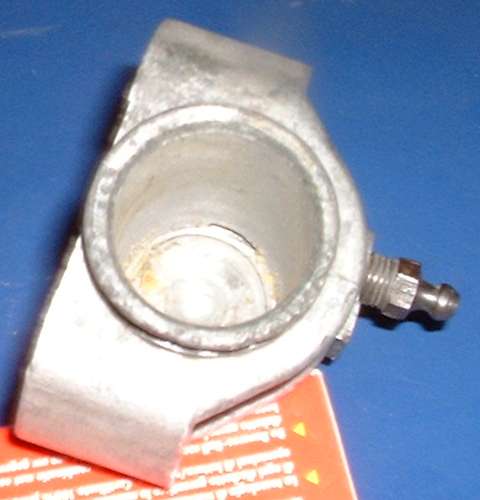
Small "slot" at back of bore is the side of the drill hole for the bleed port.
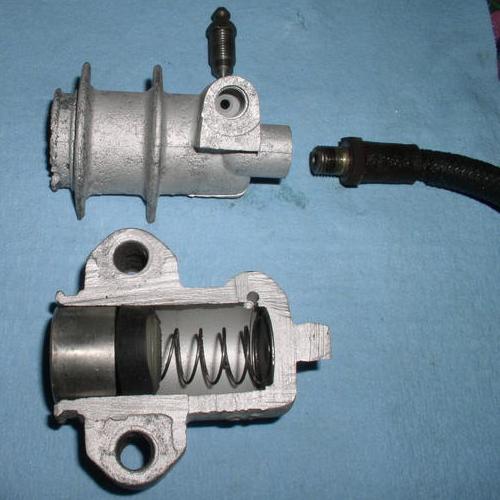
The MG clutch can be a bit of a problem to bleed, because the line runs downhill from the master cylinder to the slave, and air bubbles like to float upward. I like to say the MG clutch is notoriously difficult to bleed, but in fact it's pretty easy if you know how. The trick is to force the fluid through the line quickly so it pushes the air out with the fluid, without giving the bubbles any chance to float back up the line.
First the simple method with no special tools. Open the bleed nipple one turn. Put your finger over the end of the nipple to serve as a check valve to let the fluid escape but not to let any air back in. Have a helper pump the pedal a few times in quick succession until only liquid comes out with no air bubbles. Hold pedal down while you close the bleed nipple. Do not let the master cylinder reservoir go empty in the process, or you will have air in the line again and will be starting all over.
If that doesn't work, there are a number of other methods that can work, depending on what tools you may have at hand (or how much you want to spend on tools).
Before I go any farther, remember that there are 5 bleed nipples on the MGA 1500, or 7 on the MGA 1600 (2 on each front caliper), and 5 for Twin Cam and Deluxe cars with All Round Disk Brakes (one bleeder per caliper). Also if you have the disk brake calipers on the wrong side of the car the bleed nipples will be on the bottom, and you will never be able to get the air out of the calipers. Fix that first if necessary.
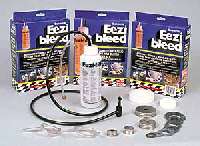 I like to use a pressure bleeder, like the Gunsons Eezi-bleed®, sold by most car parts suppliers, not cheap but a very handy tool. This is the ultimate in convenience for single handed bleeding of brakes and clutch. It works every time, and makes the job a one person project, which can be finished in a few minutes. If you browse around the net you may find instructions to build your own. This device has a bottle (with a pressure tight screw cap) which can hold more than half a quart of extra hydraulic fluid. There are two hoses attached to the cap. One hose is fairly long and has a latching air chuck to attach to the nearest tire valve for air pressure supply. The other hose is shorter, and has a fitting to attach to a screw cap which makes a pressure tight seal on the master cylinder reservoir. This hose extends through the bottle cap into the bottom of the bottle so it can take most of the fluid from the bottle before taking any air. Some larger "pro" versions of this device can have a much larger bottle, and maybe a hand pump for independent pressure.
I like to use a pressure bleeder, like the Gunsons Eezi-bleed®, sold by most car parts suppliers, not cheap but a very handy tool. This is the ultimate in convenience for single handed bleeding of brakes and clutch. It works every time, and makes the job a one person project, which can be finished in a few minutes. If you browse around the net you may find instructions to build your own. This device has a bottle (with a pressure tight screw cap) which can hold more than half a quart of extra hydraulic fluid. There are two hoses attached to the cap. One hose is fairly long and has a latching air chuck to attach to the nearest tire valve for air pressure supply. The other hose is shorter, and has a fitting to attach to a screw cap which makes a pressure tight seal on the master cylinder reservoir. This hose extends through the bottle cap into the bottom of the bottle so it can take most of the fluid from the bottle before taking any air. Some larger "pro" versions of this device can have a much larger bottle, and maybe a hand pump for independent pressure.
Assemble this thing dry first (no fluid in the bottle), and try it with pressure to be sure all of the fittings are gas tight. If the connector cap on the master cylinder leaks it may blow out the entire bottle of fluid before you notice. DOT-5 fluid is generally safe for the paint on the car (still makes a mess of course), where other fluid types may likely damage the paint before you could get it cleaned up. Once you have all pressure tight connections you can put fluid in the bottle. Normally this will hold plenty of fluid to bleed all hydraulics on the whole car with a single filling. Starting with a brand new assembly with all lines and cylinders empty, it may require a refill in mid session. If you have dirty fluid in the system, remove as much fluid as possible from the master cylinder reservoir, and refill with clean fluid before starting.
Now the nice part. Once you have the pressure bleeder filled and attached and pressurized, and enough space to work under the car, you might be able to service every bleed nipple on the car single handed in as little as five minutes. Start with the bleeder which is located farthest from the master cylinder. For an MG that would be the left rear wheel. Using a small hose on the bleed nipple and a catch container can avoid a messy fluid spill. Open the bleed nipple a turn or two, and watch the fluid squirt out. When you get clean fluid and no air bubbles, close the bleeder, it's done, and you can move on to the next bleeder. MGAs with rear drum brakes, and Spridgets with engines smaller than 1275cc (produced prior to Oct 1966), have a dual master cylinder with a single reservoir, so you can bleed all brake wheel cylinders and the clutch slave in one round. MGA Twin Cam and Deluxe models, all MGB, and all Spridgets from Oct 1966 on (1275 and 1500cc engines) have a separate master cylinder for the clutch. When finished, disconnect the air pressure hose first, and then the cap from the master cylinder.
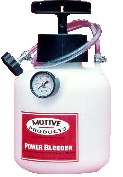 The next tool may be more or less expensive, depending on where you buy these things.
The Motive Products pressure bleeder is a self contained unit with a hand pump for pressure and a pressure gauge so you don't over do it. Available from various retailers as well as from the maker. Also see instructions for use. This works similar to the Gunsons Eezibleed, except it is pressurized with a hand pump, has a pressure gauge, and only one hose because it doesn't need the connection to a tire valve. This may come with only a single adapter cap for the master cylinder, so you may need to source another cap for each different application. Check with the vendor on that point.
The next tool may be more or less expensive, depending on where you buy these things.
The Motive Products pressure bleeder is a self contained unit with a hand pump for pressure and a pressure gauge so you don't over do it. Available from various retailers as well as from the maker. Also see instructions for use. This works similar to the Gunsons Eezibleed, except it is pressurized with a hand pump, has a pressure gauge, and only one hose because it doesn't need the connection to a tire valve. This may come with only a single adapter cap for the master cylinder, so you may need to source another cap for each different application. Check with the vendor on that point.
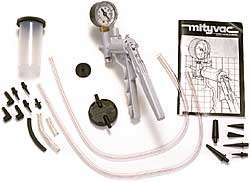 The next bleeder tool, maybe a little less expensive, is the Mityvac®. This is a hand held vacuum pump with a two push on hose connectors. It can be used for other jobs around the car requiring vacuum or low pressure, so you might own this tool for multiple purposes. The first mode of operation for bleeding hydraulics is to attach it to the bleed nipple and suck the fluid out. As usual, when you get clean fluid and no air bubbles, quit. Also do not let the master cylinder go empty, or you start all over. You might have a slight problem with air infiltration around the threads of the bleed nipple. This is more likely to be a problem with the clutch than with brakes. There is also a "pro" version of this device which is air powered using a venturi to draw a vacuum, and having a large catch container for the waste fluid. One of those things can suck a master cylinder dry in seconds, so be alert and be quick about it, and keep adding fluid to the master cylinder as required. If you can't get all the air out of the clutch line and slave cylinder this way, proceed to plan B.
The next bleeder tool, maybe a little less expensive, is the Mityvac®. This is a hand held vacuum pump with a two push on hose connectors. It can be used for other jobs around the car requiring vacuum or low pressure, so you might own this tool for multiple purposes. The first mode of operation for bleeding hydraulics is to attach it to the bleed nipple and suck the fluid out. As usual, when you get clean fluid and no air bubbles, quit. Also do not let the master cylinder go empty, or you start all over. You might have a slight problem with air infiltration around the threads of the bleed nipple. This is more likely to be a problem with the clutch than with brakes. There is also a "pro" version of this device which is air powered using a venturi to draw a vacuum, and having a large catch container for the waste fluid. One of those things can suck a master cylinder dry in seconds, so be alert and be quick about it, and keep adding fluid to the master cylinder as required. If you can't get all the air out of the clutch line and slave cylinder this way, proceed to plan B.
The second possible mode of operation for bleeding hydraulics with the Mityvac is to use it for reverse bleeding. Switch the hoses, drop the suction hose into a bottle of fresh hydraulic fluid, and put the pressure hose on the bleed nipple. This way you can push clean fluid into the bleeder, forcing any air in the line back up into the master cylinder. This is particularly effective at getting a stubborn clutch circuit primed. Do NOT allow the master cylinder reservoir to overflow while doing this. Also this will NOT get all of the air out of a slave cylinder, so you will still have to switch it around the other way to draw the last bit of air out to finish the job.
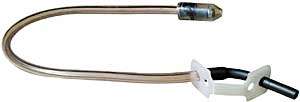 The next bleeder tool, quite a lot less expensive, is the Visibleed®. This is basically a hose with a check valve on the end. From under the car, open the bleed nipple a turn, stick the hose on the bleed nipple, drop the check valve end into a catch container. Then in the drivers seat, pump the brake (or clutch) pedal a few times to expel dirty fluid and/or air. Then back under the car, close the bleeder BEFORE disconnecting the hose. You may have to guess at how many strokes of the pedal are needed to flush each line, or this may require multiple trips under the car for inspection in process. Keep topping off the master cylinder reservoir as required. Doing this single handed you can count on at least one round trip from under car to inside and back under car for each bleed nipple, with periodic reservoir checks included. This can go much quicker with a helper to pump the pedal and maybe refill the reservoir. But then if you had a helper, you could be using your finger tip on the bleeders (or end of a clear hose) for a check valve, and you wouldn't need this tool.
The next bleeder tool, quite a lot less expensive, is the Visibleed®. This is basically a hose with a check valve on the end. From under the car, open the bleed nipple a turn, stick the hose on the bleed nipple, drop the check valve end into a catch container. Then in the drivers seat, pump the brake (or clutch) pedal a few times to expel dirty fluid and/or air. Then back under the car, close the bleeder BEFORE disconnecting the hose. You may have to guess at how many strokes of the pedal are needed to flush each line, or this may require multiple trips under the car for inspection in process. Keep topping off the master cylinder reservoir as required. Doing this single handed you can count on at least one round trip from under car to inside and back under car for each bleed nipple, with periodic reservoir checks included. This can go much quicker with a helper to pump the pedal and maybe refill the reservoir. But then if you had a helper, you could be using your finger tip on the bleeders (or end of a clear hose) for a check valve, and you wouldn't need this tool.
There is another even cheaper home grown version of this tool that MAY work in most cases. Connect a length of hose to the bleed nipple and drop it into a catch container. Position the end of the hose at the bottom of the container, preferable under a bit of fluid to begin with. Then open the bleed nipple, and pump the pedal. On the down stroke fluid and/or air "should" be expelled from the hose. On the up stroke some fluid may return up the hose, but hopefully slower and not as much as first came out. If you let air back into the exit end of the hose all bets are off. With a little luck a few strokes of the pedal may do the job, and you can close the bleed nipple BEFORE disconnecting the hose. This device can be much more positive and easier to use if you add a small check valve to the hose. A cheap but serviceable check valve might be obtained from an aquarium supply pet shop, possibly for less than a dollar (no guarantee on durability when used with brake fluid).
Here's one that was entirely new to me, but seems rather "nifty" (not to mention creative).
At 10:30 PM 7/28/04 -0400, Peter Flavin wrote:
>"Sometimes on a hyd clutch system one can use a hose put on a whl cylinder bleeder to force fluid from the brake syst. to the clutch slave and back up to the clutch master cyl. (only method working on my Midget)"
This strikes my fancy because it's a really cheap tool, and because it would be a one man job. Also with the common clutch and brake reservoir on the MGA you could pump away indefinitely and never lose any fluid (except for a little leakage at the bleeder threads). Once the clutch is working, it might even work the other way for reverse bleeding the brakes. Just don't pump so hard as to blow off the hose.
Do remember that you should still flush clean fluid through the system at least every 2 years or so to purge the crud and preserve the working parts.
Addendum 4/13/07:
John Pipe wrote:
"I found the best way to bleed the clutch, myself, is with the slave cylinder unbolted and hanging down, just push the piston up with a screw driver and let it return three times. If it is quiet, you can hear the air in the system bubble in master cylinder. Then with one last stroke, bolt it into position as the piston slowly moves back."
|




 The next bleeder tool, maybe a little less expensive, is the Mityvac®. This is a hand held vacuum pump with a two push on hose connectors. It can be used for other jobs around the car requiring vacuum or low pressure, so you might own this tool for multiple purposes. The first mode of operation for bleeding hydraulics is to attach it to the bleed nipple and suck the fluid out. As usual, when you get clean fluid and no air bubbles, quit. Also do not let the master cylinder go empty, or you start all over. You might have a slight problem with air infiltration around the threads of the bleed nipple. This is more likely to be a problem with the clutch than with brakes. There is also a "pro" version of this device which is air powered using a venturi to draw a vacuum, and having a large catch container for the waste fluid. One of those things can suck a master cylinder dry in seconds, so be alert and be quick about it, and keep adding fluid to the master cylinder as required. If you can't get all the air out of the clutch line and slave cylinder this way, proceed to plan B.
The next bleeder tool, maybe a little less expensive, is the Mityvac®. This is a hand held vacuum pump with a two push on hose connectors. It can be used for other jobs around the car requiring vacuum or low pressure, so you might own this tool for multiple purposes. The first mode of operation for bleeding hydraulics is to attach it to the bleed nipple and suck the fluid out. As usual, when you get clean fluid and no air bubbles, quit. Also do not let the master cylinder go empty, or you start all over. You might have a slight problem with air infiltration around the threads of the bleed nipple. This is more likely to be a problem with the clutch than with brakes. There is also a "pro" version of this device which is air powered using a venturi to draw a vacuum, and having a large catch container for the waste fluid. One of those things can suck a master cylinder dry in seconds, so be alert and be quick about it, and keep adding fluid to the master cylinder as required. If you can't get all the air out of the clutch line and slave cylinder this way, proceed to plan B.  The next bleeder tool, quite a lot less expensive, is the Visibleed®. This is basically a hose with a check valve on the end. From under the car, open the bleed nipple a turn, stick the hose on the bleed nipple, drop the check valve end into a catch container. Then in the drivers seat, pump the brake (or clutch) pedal a few times to expel dirty fluid and/or air. Then back under the car, close the bleeder BEFORE disconnecting the hose. You may have to guess at how many strokes of the pedal are needed to flush each line, or this may require multiple trips under the car for inspection in process. Keep topping off the master cylinder reservoir as required. Doing this single handed you can count on at least one round trip from under car to inside and back under car for each bleed nipple, with periodic reservoir checks included. This can go much quicker with a helper to pump the pedal and maybe refill the reservoir. But then if you had a helper, you could be using your finger tip on the bleeders (or end of a clear hose) for a check valve, and you wouldn't need this tool.
The next bleeder tool, quite a lot less expensive, is the Visibleed®. This is basically a hose with a check valve on the end. From under the car, open the bleed nipple a turn, stick the hose on the bleed nipple, drop the check valve end into a catch container. Then in the drivers seat, pump the brake (or clutch) pedal a few times to expel dirty fluid and/or air. Then back under the car, close the bleeder BEFORE disconnecting the hose. You may have to guess at how many strokes of the pedal are needed to flush each line, or this may require multiple trips under the car for inspection in process. Keep topping off the master cylinder reservoir as required. Doing this single handed you can count on at least one round trip from under car to inside and back under car for each bleed nipple, with periodic reservoir checks included. This can go much quicker with a helper to pump the pedal and maybe refill the reservoir. But then if you had a helper, you could be using your finger tip on the bleeders (or end of a clear hose) for a check valve, and you wouldn't need this tool.